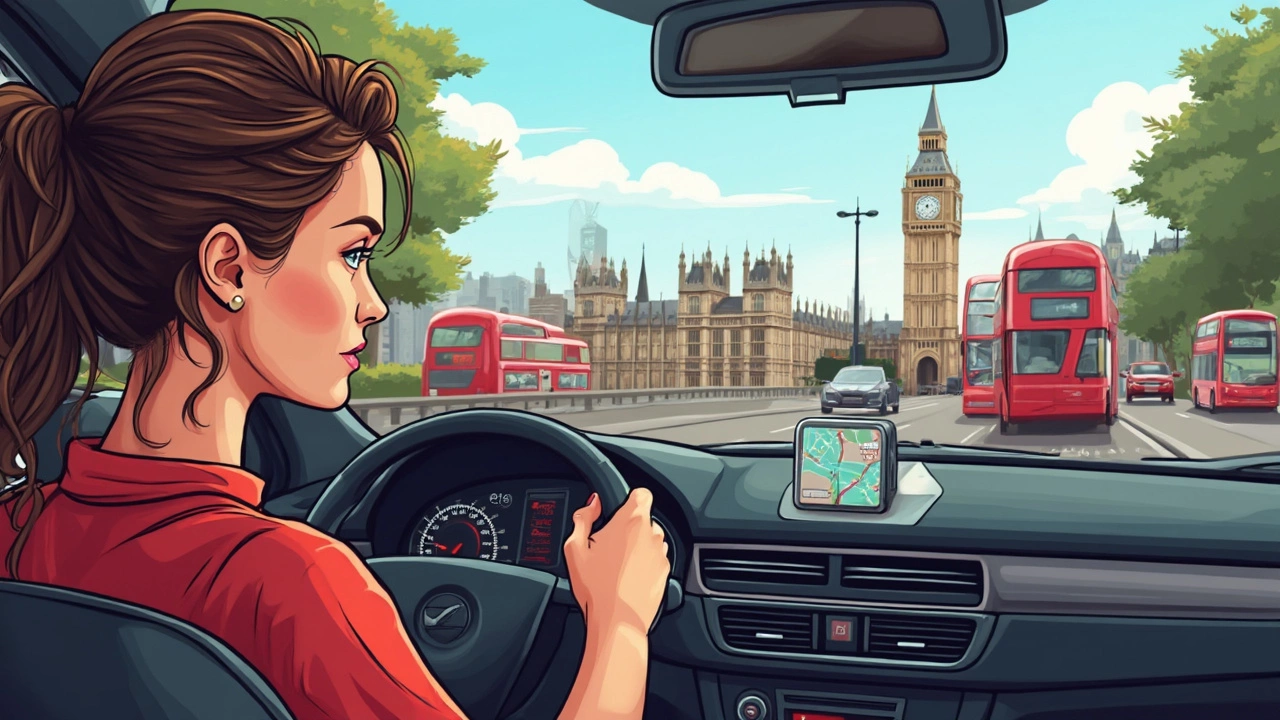Ever feel like your heart races the moment you buckle up, especially when you're driving alone? You're not alone. Staying calm in the driver's seat isn't just about comfort—it's essential for safe driving. A calm driver is less likely to make impulsive decisions and more likely to enjoy the ride.
First things first, let's talk about your driving space. Before hitting the road, take a moment to adjust your seat, mirrors, and steering wheel to find a position that feels right. Think of your car as your new best friend when driving solo; it's got your back if you keep it comfortable.
Knowing where you're headed can make a world of difference too. Take a little time to study your route. Whether you use apps like Google Maps or go old-school with a printed map, having a mental plan reduces anxiety and makes those unexpected turns less surprising.
- Why Staying Calm is Key
- Set Up Your Driving Space
- Master the Route Ahead
- Technology to the Rescue
- Mindful Driving Techniques
- Handling Stress on the Road
Why Staying Calm is Key
Ever notice how every driving safety guide emphasizes keeping your cool on the road? There's a good reason for that. Staying calm isn't just about avoiding road rage; it's about maintaining focus, making clearer decisions, and ultimately keeping yourself and others safe.
Improved Reaction Times
When you're calm, your brain processes information more efficiently. This means you can react quicker to sudden obstacles like a pedestrian jaywalking or a car braking unexpectedly. Studies show that stress can slow down your reaction time by up to 30%. Keeping a clear head helps you stay sharp and attentive.
Better Decision Making
Driving alone without distractions allows you to make decisions based on logic rather than emotion. A calm driver can anticipate potential hazards and choose the best path forward without panicking. For instance, instead of slamming the brakes when you see a yellow light, you might decide to coast safely through if it's more appropriate.
Reduced Anxiety for a Smoother Ride
Ever had that tension in your shoulders after a long drive? That's stress talking. Learning to stay calm can help reduce not just mental stress, but physical strain too. You enjoy your drive more, leading to a smoother, more pleasant ride.
Statistics on Stress-Free Driving
Consider this: research shows that stress-free driving can reduce the likelihood of an accident by up to 25%. That's a significant number and a great reason to focus on staying calm, whether you're navigating city streets or cruising down the highway.
Set Up Your Driving Space
Imagine stepping into a cockpit rather than just a car. This setup is going to be your sanctuary, especially when you're driving alone. A well-thought-out space can make all the difference when it comes to staying calm and focused.
Adjust Your Seat and Mirrors
First up, make sure your seat is at the right height and distance from the pedals. You should be able to easily push the pedals without straining too much. Now, let's tackle the mirrors. Adjust them so there's minimal blind spot; you want to see as much of the road as possible without twisting around every few seconds.
"The simplest adjustments to your seat and mirrors have the potential to significantly improve your comfort, control, and overall safety," says Mark Gallagher, a driving safety expert.
Temperature and Ventilation
A too-hot or too-cold car isn't just uncomfortable; it can seriously mess with your mood. Set a temperature that's comfortable, maybe crack a window or adjust the vents for some fresh air. Trust me; it helps in keeping that right frame of mind.
Control the Noise
Next, think about what you're going to listen to. Sometimes a bit of silence works wonders, but if that's not your thing, have a calming playlist or an interesting podcast ready. Avoid anything too distracting, though.
Have Quick Access to Essentials
Make sure your essential items like your phone (for emergencies, not distractions!), water bottle, and registration papers are within easy reach. It's all about having what you need without having to dig around while driving.
- Seat: Comfortable and correctly positioned.
- Mirrors: Adjusted to minimize blind spots.
- Temperature: Just right for comfort.
- Noise: Ideally calming or none at all.
- Essentials: Easily reachable without distraction.
Getting your driving space set up right isn't just about physical comfort; it's your first line of defense against road stress. Master it, and even those long drives won't feel so daunting.
Master the Route Ahead
One way to boost your calm driving experience when going solo is mastering your route. Knowing the roads can ease those nerves and make your journey less like an unplanned adventure.
Study Your Path
Before you head out, take a few minutes to look at the map. It's not just about reaching point B; it's knowing what to expect. Use apps like Google Maps or Waze to get a sense of the route's layout, traffic patterns, and any ongoing construction work. By doing this, you can prepare for potential delays and detours.
Check the Traffic
Tune into local traffic updates or use your phone's navigation app to get real-time traffic conditions. Knowing which areas are congested can help you decide on alternative routes, saving time and avoiding frustration.
Practice Makes Perfect
If it's a route you haven't driven before, consider a practice run during off-peak hours. Familiarity breeds confidence, and you'll be more relaxed when you hit the road for real.
Emergency Stops and Exits
Identify emergency stops and rest areas along the way. It's good to know you have options if you need a quick break or a moment to refocus.
Remember, the key to stress-free, solo driving is anticipation and preparation. By mastering your route, you'll find your drives are smoother, safer, and even enjoyable.

Technology to the Rescue
Let's face it, technology has revolutionized how we drive these days, and it’s a lifesaver when you're hitting the road alone. From navigation apps to driver assistance systems, tech can really be a game changer in making driving solo smoother and more stress-free.
Navigation Apps
Remember the days of unfolding giant maps? Those days are gone. With navigation apps like Google Maps and Waze, you can't go wrong. They offer real-time traffic updates, estimated travel times, and even alternative routes if you hit a jam. It's like having a co-pilot who never gets tired. Just plug in your destination, and you're good to go.
According to a study published by 'Drivers Today,' navigating with apps reduces travel-related stress by up to 60%.
Driver Assistance Systems
Newer cars come with a suite of driver assistance systems. Ever heard of adaptive cruise control? It automatically adjusts your speed to maintain a safe distance from the vehicle in front. Lane-keeping assist is another nifty feature that helps you stay centered on the road. These systems act like a second pair of eyes, letting you feel more relaxed behind the wheel.
Hands-Free Calling and Music
Keeping your hands on the wheel and eyes on the road is a must. Hands-free calling ensures you stay connected without getting distracted. Bluetooth integration with your car audio lets you take calls with a simple button touch. And who doesn't love a road trip playlist? Cue up your music hands-free and let the good vibes roll.
While you're embracing this tech, it's vital to remember to not rely entirely on it. Apps and gadgets can enhance your drive, but good old common sense is crucial. Use technology wisely to create a calm and collected driving experience.
Mindful Driving Techniques
Driving solo doesn’t have to be a nerve-wracking experience. Incorporating a few mindful driving techniques can make your journey smoother and stress-free. Not only will it keep you calm, but it can enhance your overall driving skills.
Focus on Your Breathing
Start with something as simple as your breath. Whenever you feel tension creeping in, try some deep breathing. Inhale slowly through your nose, hold it for a second, then exhale through your mouth. Doing this a few times can instantly reduce stress and bring your focus back on the road.
The 20-20-20 Rule
If long drives are on the agenda, keeping your eyes healthy is crucial. This simple rule is easy to remember: every 20 minutes, take a 20-second break to look at something 20 feet away. It helps prevent eye strain, keeping you alert for those solo rides.
Music and Driving
While blaring your favorite tunes can be fun, studies suggest that soft, calming music can actually enhance concentration and promote a calm driving environment. Consider compiling a playlist that keeps you relaxed and focused at the same time.
Embrace the Power of Pause
Scared of driving through rush hour or heavy traffic? Pull over safely and take a short break. By stepping out for a stretch or simply pausing in a safe spot, you reset your mind and body, ready to tackle the rest of the journey with renewed energy.
Practice Scanner Vision
Instead of fixating on just one point, like the car ahead, practice 'scanning'. This means constantly being aware of your surroundings — side mirrors, road signs, and pedestrians. Being aware not only keeps stress at bay but also enhances your vigilance.
Keep Distractions at Bay
Your phone, the in-car gadgets — all these can distract you without you realizing it. Engage 'Do Not Disturb' while driving or keep your phone out of reach. It’s a small change but makes a big impact on keeping you focused and stress-free.
By integrating these mindful driving tips, you're setting yourself up for safer, calmer solo drives. Whether you're heading to work or going on a road trip, these strategies ensure you arrive both safely and serenely.
Handling Stress on the Road
Got sweaty palms while driving? Stress is a common passenger, but it doesn't have to take the wheel. Managing stress effectively can transform your solo drive into a breeze. So, how can you keep your cool when the traffic gets hot?
Breathe Easy
Seems simple, right? But when things start to feel overwhelming, taking a few deep breaths can actually be your best bet. Try inhaling through your nose for four counts, holding for four, and then exhaling through your mouth for four. Repeat this until you feel a bit more relaxed.
Music for the Mood
Create playlists that keep you calm. Whether it's smooth jazz or your favorite pop hits, having the right tunes can impact your mood and make the drive much more enjoyable. Avoid songs that might pump up your adrenaline too much—save those for gym time!
Keep the Focus
It's easy to let your mind wander while driving. To tether your focus back, actively narrate what's going on around you like a podcast host. Talk through what you see and your next move. This simple trick keeps you engaged and grounded in the present moment.
Embrace Tech Wisely
Using navigational apps is great, but sometimes they can add stress with unexpected reroutes. Check your app settings to limit notifications and simplify the display to avoid being bombarded with info. Technology should be your co-pilot, not your dictator.
Stay Hydrated
You'd be surprised how much a sip of water can help calm nerves. Dehydration sneaks up on you, causing fatigue and irritability. Keep a water bottle handy to sip throughout your journey to stay alert and stress-free.
Break Time
Long stretches behind the wheel can be draining. Plan breaks if you're going on a long trip. Getting out, stretching your legs, and breathing in fresh air helps reset your mind and body.
Drive time doesn't have to be stress time. With these tips in mind, you'll tackle that solo drive like a pro, turning a stressful ride into a relaxing retreat on wheels.

